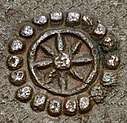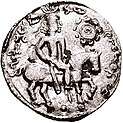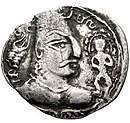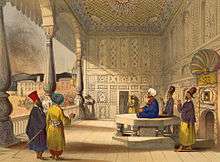Alchon Huns
The Alchon Huns, also known as the Alchono, Alxon, Alkhon, Alkhan, Alakhana and Walxon, were a nomadic people who established states in Central Asia and South Asia during the 4th and 6th centuries CE.[1] They were first mentioned as being located in Paropamisus, and later expanded south-east, into the Punjab and central India, as far as Eran and Kausambi. The Alchon invasion of the Indian subcontinent eradicated the Kidarite Huns who had preceded them by about a century, and contributed to the fall of the Gupta Empire, in a sense bringing an end to Classical India.[3][4]
Alchon Huns | |||||||||||||||||||
|---|---|---|---|---|---|---|---|---|---|---|---|---|---|---|---|---|---|---|---|
| 370–670 | |||||||||||||||||||
| Capital | Kapisa | ||||||||||||||||||
| Common languages | Brahmi and Bactrian (written) | ||||||||||||||||||
| Religion | Hinduism, Buddhism | ||||||||||||||||||
| Government | Nomadic empire | ||||||||||||||||||
| Historical era | Late Antiquity | ||||||||||||||||||
• Established | 370 | ||||||||||||||||||
• Disestablished | 670 | ||||||||||||||||||
| Currency | Drachm | ||||||||||||||||||
| |||||||||||||||||||
| Today part of | Afghanistan Pakistan India | ||||||||||||||||||
The invasion of India by the Huna peoples follows invasions of the subcontinent in the preceding centuries by the Yavana (Indo-Greeks), the Saka (Indo-Scythians), the Palava (Indo-Parthians), and the Kushana (Yuezhi). The Alchon Empire was the third of four major Huna states established in Central and South Asia. The Alchon were preceded by the Kidarites and the Hephthalites, and succeeded by the Nezak Huns. The names of the Alchon kings are known from their extensive coinage, Buddhist accounts, and a number of commemorative inscriptions throughout the Indian subcontinent.
The Alchons have long been considered as a part or a sub-division of the Hephthalites, or as their eastern branch, but now tend to be considered as a separate entity.[1][5][6]
Name
To contemporaneous observers in India, the Alchon were one of the Hūṇa peoples (or Hunas),[7] whose origins are controversial. A seal from Kausambi associated with Toramana, bears the title Hūnarāja ("Huna King").[8] Toramana is also described as a Huna (![]()
![]()
The Hunas appear to have been the peoples known in contemporaneous Iranian sources as Xwn, Xiyon and similar names, which were later Romanised as Xionites or Chionites. The Hunas are often linked to the Huns that invaded Europe from Central Asia during the same period. Consequently, the word Hun has three slightly different meanings, depending on the context in which it is used: 1) the Huns of Europe; 2) groups associated with the Huna people who invaded northern India; 3) a vague term for Hun-like people. The Alchon have also been labelled "Huns", with essentially the second meaning, as well as elements of the third.[14][15]
The name "Alchon" generally given to them comes from the Bactrian legend of their early coinage, where they simply imitated Sassanian coins to which they added the name "alchono" (αλχονο, also αλχοννο)[16] in Bactrian script (a slight adaptation of the Greek script) and the tamgha symbol of their clan.[17][18][11][19] Several original coins such as those of Khingila also bear the mention "alchono" together with the Tamgha symbol.[11] Philologically, "alchono" (αλχονο) may be a combination of al- for Aryan and -xono for Huns, although this remains hypothetical.[12] Another etymology could be al-, Turkish for scarlet, and -xono for Huns, meaning "Red Huns", red being a symbol of the south among steppe nomads.[20]
History
Invasion of Bactria (370 CE)
During the reign of Shapur II, the Sasanian Empire and the Kushano-Sasanians gradually lost the control of Bactria to these invaders from Central Asia, first the Kidarites from around 335 CE, then the Hephthalites and the Alchon Huns from 370 CE, who would follow up with the invasion of India.[23]
Early confrontations between the Sasanian Empire of Shapur II with the nomadic hordes from Central Asia called the "Chionites" were described by Ammianus Marcellinus: he reports that in 356 CE, Shapur II was taking his winter quarters on his eastern borders, "repelling the hostilities of the bordering tribes" of the Chionites and the Euseni ("Euseni" is usually amended to "Cuseni", meaning the Kushans),[24][25] finally making a treaty of alliance with the Chionites and the Gelani, "the most warlike and indefatigable of all tribes", in 358 CE.[26] After concluding this alliance, the Chionites (probably of the Kidarites tribe)[27] under their King Grumbates accompanied Shapur II in the war against the Romans, especially at the Siege of Amida in 359 CE. Victories of the Xionites during their campaigns in the Eastern Caspian lands were also witnesses and described by Ammianus Marcellinus.[28]
The Alchon Huns occupied Bactria circa 370 CE, where they started minting coins in the style of Shapur II but bearing their name "Alchono", and emerged in Kapisa around 380, taking over Kabulistan from the Sassanian Persians, at the same time the Kidarites (Red Huns) still ruled in Ghandara. The Alchon Huns are said to have taken control of Kabul in 388.[7]
The Alchon Huns initially issued anonymous coins based on Sasanian designs.[21] Several types of these coins are known, usually minted in Bactria, using Sasanian coinage designs with busts imitating Sasanian kings Shapur II (r.309 to 379 CE) and Shapur III (r.383 to 388 CE), adding the Alchon Tamgha ![]()
Gandhara (460 CE)
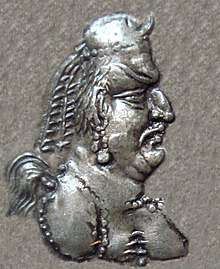
Around 430 King Khingila, the most notable Alchon ruler, and the first one to be named and represented on his coins with the legend "χιγγιλο" (Kiggilo) in Bactrian, emerged and took control of the routes across the Hindu Kush from the Kidarites.[7][1] He seems to have been a contemporary of the Sassanian ruler Bahram V.[1] As the Alchons took control, diplomatic missions were established in 457 with China.[32]:162 Khingila, under the name Shengil, was called "King of India" in the Shahnameh of Ferdowsi.[6]
Alchon ruler Mehama (r.461-493) was elevated to the position of Governor for Sasanian Emperor Peroz I (r. 459-484), and described himself as "King of the people of Kadag and governor of the famous and prosperous King of Kings Peroz" in a 462-463 letter.[33] He allied with Peroz I in his victory over the Kidarites in 466 CE, and may also have helped him take the throne against his brother Hormizd III.[34] But he was later able to wrestle autonomy or even independence.[34]
Between 460 and 470 CE, the Alchons took over Gandhara and the Punjab which also had remained under the control of the Kidarites, while the Gupta Empire remained further east.[35][15] They apparently undertook the mass destruction of Buddhist monasteries and stupas at Taxila, a high center of learning, which never recovered from the destruction.[36] Virtually all of the Alchon coins found in the area of Taxila were found in the ruins of burned down monasteries, where apparently some of the invaders died alongside local defenders during the wave of destructions.[36] It is thought that the Kanishka stupa, one of the most famous and tallest buildings in antiquity, was destroyed by them during their invasion of the area in the 460s CE.[37]
The rest of the 5th century marks a period of territorial expansion and eponymous kings, several of which appear to have overlapped and ruled jointly.[38][Note 1] The Alchon Huns invaded parts of northwestern India from the second half of the 5th century.[39] According to the Bhitari pillar inscription, the Gupta ruler Skandagupta already confronted and defeated an unnamed Huna ruler circa 456-457 CE.[39]
Sindh

From circa 480 CE, there are also suggestion of Hunnic occupation of Sindh, between Multan and the mouth of the Indus river, as the local Sasanian coinage of Sindh starts to incorporate sun symbols or a Hunnic tamgha to the design.[40] These little-known coins are usually described as the result of the invasions of the "Hephthalites".[40] The quality of the coins also becomes very much degraded by that time, and the actual gold content becomes quite low compared to the previous Sasanian-style coinage.[41]
Contributions
The Hūṇas were precisely ruling the area of Malwa, at the doorstep of the Western Deccan, at the time the famous Ajanta caves were made by ruler Harisena of the Vakataka Empire.[42][43] Through their control of vast areas of northwestern India, the Huns may actually have acted as a cultural bridge between the area of Gandhara and the Western Deccan, at the time when the Ajanta or Pitalkhora caves were being decorated with designs of Gandharan inspiration, such as Buddhas dressed in robes with abundant folds.[44]
First Hunnic War: Central India
In the First Hunnic War (496–515),[2] the Alchon reached their maximum territorial extent, with King Toramana pushing deep into Indian territory, reaching Gujarat and Madhya Pradesh in Central India, and ultimately contributing to the downfall of the Gupta Empire.[32]:162 To the south, the Sanjeli inscriptions indicate that Toramana penetrated at least as far as northern Gujarat, and possibly to the port of Bharukaccha.[46] To the east, far into Central India, the city of Kausambi, where seals with Toramana's name were found, was probably sacked by the Alkhons in 497–500, before they moved to occupy Malwa.[2][47][48]:70[49] In particular, it is thought that the monastery of Ghoshitarama in Kausambi was destroyed by Toramana, as several of his seals were found there, one of them bearing the name Toramana impressed over the official seal of the monastery, and the other bearing the title Hūnarāja ("King of the Huns"), together with debris and arrowheads.[8] Another seal, this time by Mihirakula, is reported from Kausambi.[8] These territories may have been taken from Gupta Emperor Budhagupta.[48]:79 Alternatively, they may have been captured during the rule of his successor Narasimhagupta.[50]
First Battle of Eran (510 CE)
A decisive battle occurred in Malwa, where a local Gupta ruler, probably a governor, named Bhanugupta was in charge. In the Bhanugupta Eran inscription, this local ruler reports that his army participated in a great battle in 510 CE at Eran, where it suffered severe casualties.[50] Bhanugupta was probably vanquished by Toramana at this battle, so that the western Gupta province of Malwa fell into the hands of the Hunas.[50]
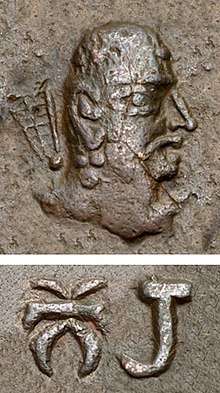
According to a 6th-century CE Buddhist work, the Manjusri-mula-kalpa, Bhanugupta lost Malwa to the "Shudra" Toramana, who continued his conquest to Magadha, forcing Narasimhagupta Baladitya to make a retreat to Bengal. Toramana "possessed of great prowess and armies" then conquered the city of Tirtha in the Gauda country (modern Bengal).[51][Note 2] Toramana is said to have crowned a new king in Benares, named Prakataditya, who is also presented as a son of Narasimha Gupta.[52][50]
Mahārājadhirāja Shrī Toramāṇa
"Great King of Kings, Lord Toramana"
in the Eran boar inscription of Toramana in the Gupta script.[54]
Having conquered the territory of Malwa from the Guptas, Toramana was mentioned in a famous inscription in Eran, confirming his rule on the region.[50] The Eran boar inscription of Toramana (in Eran, Malwa, 540 km south of New Delhi, state of Madhya Pradesh) of his first regnal year indicates that eastern Malwa was included in his dominion. The inscription is written under the neck of the boar, in 8 lines of Sanskrit in the Brahmi script. The first line of the inscription, in which Toramana is introduced as Mahararajadhidaja (The Great King of Kings),[48]:79 reads:
"In year one of the reign of the King of Kings Sri-Toramana, who rules the world with splendor and radiance..."
On his gold coins minted in India in the style of the Gupta Emperors, Toramana presented himself confidently as:
""Avanipati Torama(no) vijitya vasudham divam jayati"
"The lord of the Earth, Toramana, having conquered the Earth, wins Heaven"
The fact that the Alchon Huns issued gold coins, such as the Toramana issue, in addition to their silver and copper coins, suggest that their empire in India was quite rich and powerful.[57]
Defeat (515 CE)
Toramana was finally defeated by local Indian rulers. The local ruler Bhanugupta is sometimes credited with vanquishing Toramana, as his 510 CE inscription in Eran, recording his participation in "a great battle", is vague enough to allow for such an interpretation. The "great battle" in which Bhanagupta participated is not detailed, and it is impossible to know what it was, or which way it ended, and interpretations vary.[58][59][60] Mookerji and others consider, in view of the inscription as well as the Manjusri-mula-kalpa, that Bhanugupta was, on the contrary, vanquished by Toramana at the 510 CE Eran battle, so that the western Gupta province of Malwa fell into the hands of the Hunas at that point,[50][52] so that Toramana could be mentioned in the Eran boar inscription, as the ruler of the region.[50]
Toramana was finally vanquished with certainty by an Indian ruler of the Aulikara dynasty of Malwa, after nearly 20 years in India. According to the Rīsthal stone-slab inscription, discovered in 1983, King Prakashadharma defeated Toramana in 515 CE.[2][46][61] The First Hunnic War thus ended with a Hunnic defeat, and Hunnic troops apparently retreated to the area of Punjab.[2] The Manjusri-mula-kalpa simply states that Toramana died in Benares as he was returning westward from his battles with Narasimhagupta.[50]
Second Hunnic War: to Malwa and retreat

The Second Hunnic War started in 520, when the Alchon king Mihirakula, son of Toramana, is recorded in his military encampment on the borders of the Jhelum by Chinese monk Song Yun.[2] At the head of the Alchon, Mihirakula is then recorded in Gwalior, Central India as "Lord of the Earth" in the Gwalior inscription of Mihirakula.[2] According to some accounts, Mihirakula invaded India as far as the Gupta capital Pataliputra, which was sacked and left in ruins.[62][48]:64
There was a king called Mo-hi-lo-kiu-lo (Mihirakula), who established his authority in this town (Sagala) and ruled over India. He was of quick talent, and naturally brave. He subdued all the neighbouring provinces without exception.
The destructions of Mihirakula are also recorded in the Rajatarangini:[6]
“Mihirakula, a man of violent acts and resembling Kāla (Death) ruled in the land which was overrun by hordes of Mlecchas… the people knew his approach by noticing the vultures, crows, and other [birds], which were flying ahead to feed on those who were being slain within his army’s [reach]”
— The Rajatarangini[6]
Finally however, Mihirakula was defeated in 528 by an alliance of Indian principalities led by Yasodharman, the Aulikara king of Malwa, in the battle of Sondani in Central India, which resulted in the loss of Alchon possessions in the Punjab and north India by 542. The Sondani inscription in Sondani, near Mandsaur, records the submission by force of the Hunas, and claims that Yasodharman had rescued the earth from rude and cruel kings,[64][Note 3] and that he "had bent the head of Mihirakula".[2] In a part of the Sondani inscription Yasodharman thus praises himself for having defeated king Mihirakula:[53]
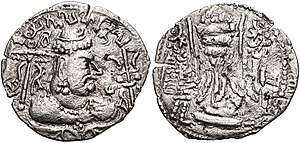
He (Yasodharman) to whose two feet respect was paid, with complimentary presents of the flowers from the lock of hair on the top of (his) head, by even that (famous) king Mihirakula, whose forehead was pained through being bent low down by the strength of (his) arm in (the act of compelling) obeisance
The Gupta Empire emperor Narasimhagupta is also credited in helping repulse Mihirakula, after the latter had conquered most of India, according to the reports of Chinese monk Xuanzang.[71][72] In a fanciful account, Xuanzang, who wrote a century later in 630 CE, reported that Mihirakula had conquered all India except for an island where the king of Magadha named Baladitya (who could be Gupta ruler Narasimhagupta Baladitya) took refuge, but that was finally captured by the Indian king. He later spared Mihirakula's life on the intercession of his mother, as she perceived the Hun ruler "as a man of remarkable beauty and vast wisdom".[72] Mihirakula is then said to have returned to Kashmir to retake the throne.[73][32]:168 This ended the Second Hunnic War in c. 534, after an occupation which lasted nearly 15 years.[2]
Retreat to Gandhara and Kashmir (530 CE)
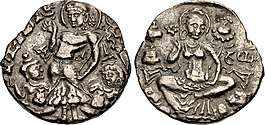
The Alchon Huns resettled in the area of Gandhara and Kashmir in northwestern India under the rule of Sri Pravarasena (c.530-590 CE), thought to be the son of Toramana.[74] His reign probably lasted about 60 years from circa 530 CE.[74][75] According to Kalhana's 12th century text Rajatarangini, Pravarasena established a new capital named Pravarapura (also known as Pravarasena-pura). Based on topographical details, Pravarapura appears to be same as the modern city of Srinagar.[76][74] He also built a temple named "Pravaresha".[74][75]
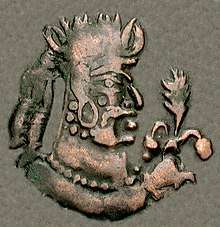
Pravarasena was probably succeeded by a king named Gokarna, a follower of Shiva, and then by his son king Narendraditya Khinkhila.[75][74] The son of Narendraditya was Yudhishthira, who succeeded him as king, and was the last known king of the Alchon Huns.[74] According to the Rajatarangini, Yudhishthira ruled 40 years until circa 670 CE, but he was dethroned by Pratapaditya, son of the founder of the Karkoṭa Empire, Durlabhvardhana.[77]
Retreat to Kabulistan
Around the end of the 6th century CE, the Alchons withdrew to Kashmir and, pulling back from Punjab and Gandhara, moved west across the Khyber pass where they resettled in Kabulistan. There, their coinage suggests that they merged with the Nezak – as coins in Nezak style now bear the Alchon tamga mark.[78][53]
During the 7th century, continued military encounters are reported between the Hunas and the northern Indian states which followed the disappearance of the Gupta Empire. For example, Prabhakaravardhana, the Vardhana dynasty king of Thanesar in northern India and father of Harsha, is reported to have been "A lion to the Huna deer, a burning fever to the king of the Indus land".[79]:253
The Alchons in India declined rapidly around the same time that the Hephthalites, a related group to the north, were defeated by an alliance between the Sassanians and the Western Turkic Kaghanate.[80]:187 Eventually, the Nezak-Alchons were replaced by the Turk shahi dynasty.[80]:187
Religion and ethics
The four Alchon kings Khingila, Toramana, Javukha, and Mehama are mentioned as donors to a Buddhist stupa in the Talagan copper scroll inscription dated to 492 or 493 CE, that is, at a time before the Hunnic wars in India started. This corresponds to a time when the Alchons had recently taken control of Taxila (around 460 CE), at the center of the Buddhist regions of northwestern India.[81]
Persecution of Buddhism
Later, however, the attitude of the Alchons towards Buddhism is reported to have been negative. Mihirakula in particular is remembered by Buddhist sources to have been a "terrible persecutor of their religion" in Gandhara in northern Pakistan.[82] During his reign, over one thousand Buddhist monasteries throughout Gandhara are said to have been destroyed.[83] In particular, the writings of Chinese monk Xuanzang from 630 CE explained that Mihirakula ordered the destruction of Buddhism and the expulsion of monks.[32]:162 Indeed, the Buddhist art of Gandhara, in particular Greco-Buddhist art, becomes essentially extinct around that period. When Xuanzang visited northwestern India in c. 630 CE, he reported that Buddhism had drastically declined, and that most of the monasteries were deserted and left in ruins.[84]
Although the Guptas were traditionally a Brahmanical dynasty,[85] around the period of the invasions of the Alchon the Gupta rulers had apparently been favouring Buddhism. According to contemporary writer Paramartha, Mihirakula's supposed nemesis Narasimhagupta Baladitya was brought up under the influence of the Mahayanist philosopher Vasubandhu.[85] He built a sangharama at Nalanda and a 300 ft (91 m) high vihara with a Buddha statue within which, according to Xuanzang, resembled the "great Vihara built under the Bodhi tree". According to the Manjushrimulakalpa (c. 800 CE), king Narasimhsagupta became a Buddhist monk, and left the world through meditation (Dhyana).[85] Xuanzang also noted that Narasimhagupta Baladitya's son Vajra, who also commissioned a sangharama, "possessed a heart firm in faith".[86]:45[87]:330
The 12th century Kashmiri historian Kalhana also painted a dreary picture of Mihirakula's cruelty, as well as his persecution of the Buddhist faith:
"In him, the northern region brought forth, as it were, another god of death, bent in rivalry to surpass... Yama (the god of death residing in the southern regions). People knew of his approach by noticing the vultures, crows and other birds flying ahead eager to feed on those who were being slain within his army's reach. The royal Vetala (demon) was day and night surrounded by thousands of murdered human beings, even in his pleasure houses. This terrible enemy of mankind had no pity for children, no compassion for women, no respect for the aged"
Shivaism and Sun cult
The Alchons are generally described as sun worshipers, a traditional cult of steppe nomads. This stems from the appearance of sun symbols on some of their coins, combined with the probable influence they received from the worship of Surya in India.[88] Mihirakula is also said to have been an ardent worshiper of Shiva,[89][90] although he may have been selectively attracted to the destructive powers of the Indian deity.[72]
Mihirakula is said to have been the founder of the Shankaracharya Temple, a shrine dedicated to Shiva in Srinagar,[91][92] a shrine to Shiva named Mihiresvara in Halada, and a large city called Mihirapura.[92]
Consequences on India
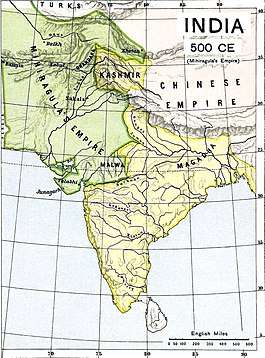
The Alchon invasions, although only spanning a few decades, had long term effects on India, and in a sense brought an end to the middle kingdoms of India.[72] Soon after the invasions, the Gupta Empire, already weakened by these invasions and the rise of local rulers, ended as well.[79]:221 Following the invasions, northern India was left in disarray, with numerous smaller Indian powers emerging after the crumbling of the Guptas.[93]
The Huna invasions are said to have seriously damaged India's trade with Europe and Central Asia,[72] particularly Indo-Roman trade relations, which the Gupta Empire had greatly benefited from. The Guptas had been exporting numerous luxury products such as silk, leather goods, fur, iron products, ivory, pearl and pepper from centers such as Nasik, Paithan, Pataliputra and Benares. The Huna invasion probably disrupted these trade relations and the tax revenues that came with them.[94] Furthermore, Indian urban culture was left in decline, and Buddhism, gravely weakened by the destruction of monasteries and the killing of monks, started to collapse.[72] Great centers of learning were destroyed, such as the city of Taxila, bringing cultural regression.[72] The art of Mathura suffered greatly from the destructions brought by the Hunas, as did the art of Gandhara in the northwest, and both schools of art were nearly wiped out under the rule of the Huna Mihirakula.[95]
During their rule of 60 years, the Alchons are said to have altered the hierarchy of ruling families and the Indian caste system. For example, the Hunas are often said to have become the precursors of the Rajputs.[72] On the artistic side however, the Alchon Huns may have played a role, just like the Western Satraps centuries before them, in helping spread the art of Gandhara to the western Deccan region.[96]
Coinage legacy (6th-12th century CE)
As they invaded northern and central India circa 500 CE, the Alchon Huns issued several types of coinage on the model of the Sasanian Empire, with ruler in profile on the obverse and sacred fire with attendants on the reverse.[97] It is thought that in the process of minting coins in occupied lands, they transmitted Sasanian coin designs to northern and western India.[97] This created a major type of Indian coinage called "Indo-Sasanian coinage", which lasted in degraded form until the 12th century CE as far as the Gangetic region.[97]
Sources
Ancient sources refer to the Alchons and associated groups ambiguously with various names, such as Huna in Indian texts, and Xionites in Greek texts. Xuanzang chronicled some of the later history of the Alchons.[71]
Modern archeology has provided valuable insights into the history of the Alchons. The most significant cataloguing of the Alchon dynasty came in 1967 with Robert Göbl's analysis of the coinage of the "Iranian Huns".[98] This work documented the names of a partial chronology of Alchon kings, beginning with Khingila. In 2012, the Kunsthistorisches Museum completed a reanalysis of previous finds together with a large number of new coins that appeared on the antiquities market during the Second Afghan Civil War, redefining the timeline and narrative of the Alchons and related peoples.[80]
Talagan copper scroll
A significant contribution to our understanding of Alchon history came in 2006 when Gudrun Melzer and Lore Sander published their finding of the "Talagan copper scroll", also known as the "Schøyen Copper Scroll", dated to 492 or 493, that mentions the four Alchon kings Khingila, Toramana, Javukha, and Mehama (who was reigning at the time) as donors to a Buddhist reliquary stupa.[99][Note 4][Note 5]
Rulers
| Alchon Huns (400–670 CE) | |||||||||||||||||||||||||||||||||||||||
|---|---|---|---|---|---|---|---|---|---|---|---|---|---|---|---|---|---|---|---|---|---|---|---|---|---|---|---|---|---|---|---|---|---|---|---|---|---|---|---|
|
|||||||||||||||||||||||||||||||||||||||
The rulers of the Alchons practiced skull deformation, as evidenced from their coins, a practice shared with the Huns that migrated into Europe. The names of the first Alchon rulers do not survive. Starting from 430 CE, names of Alchon kings survive on coins[98] and religious inscriptions:[99]
- anonymous kings (400 - 430 CE)
- Khingila (c. 430 – 490 CE)
- Javukha/Zabocho (c. mid 5th – early 6th CE)
- Mehama (c. 461 – 493 CE)
- Lakhana Udayaditya (c. 490's CE)
- Aduman
- Toramana (c. 490 – 515 CE)
- Mihirakula (c. 515 – 540 CE)
- Pravarasena (c. 530 – 590 CE)
- Toramana II (c. 530 – 570 CE)
- Gokarna (c. 570 – 590 CE)
- Narana/Narendra (c. 590 – 630 CE)
- Yudhishthira (630-670 CE)
Coinage

- Early Bactrian coinage based on Sasanian designs
The earliest Alchon Hun coins were based on Sasanian designs, often with the simple addition of the Alchon tamgha and a mention of "Alchon" or "Alkhan".[21] Various coins minted in Bactria and based on Sasanian designs are known, often with busts imitating Sasanian kings Shapur II (r.309 to 379 CE) and Shapur III (r.383 to 388 CE), with attendants to a fire altar on the reverse.[29][101] It is thought that the Sasanids lost control of Bactria to the Kidarites during the reign of Shapur II circa 370 CE, followed by the Hephthalites, and subsequently by the Alchon.[23]
- Later original coinage
Later Alchon coinage became original and differed from predecessors in that it was devoid of Iranian (Sasanian) symbolism.[7] The rulers are depicted with elongated skulls, apparently a result of artificial cranial deformation.[7]
After their invasion of India the coins of the Alchon were numerous and varied, as they issued copper, silver and gold coins, sometimes roughly following the Gupta pattern. The Alchon empire in India must have been quite significant and rich, with the ability to issue a significant volume of gold coins.[102]
Main coin types
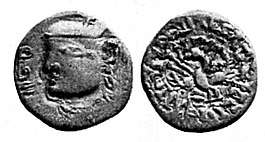 Silver coin of Toramana in Western Gupta style, with the Gupta peacock and Brahmi legend on the reverse. Similar to the silver coin type of Skandagupta. On the obverse the date "52" is also inscribed.[103] A modern image: .
Silver coin of Toramana in Western Gupta style, with the Gupta peacock and Brahmi legend on the reverse. Similar to the silver coin type of Skandagupta. On the obverse the date "52" is also inscribed.[103] A modern image: . Alchon Tamgha symbol on a coin of Khingila.
Alchon Tamgha symbol on a coin of Khingila.

- Silver drachm of Khingila (mature portrait), Bactrian legend: χιγγιλο αλχοννο "Khiggilo Alchono".[Note 7]
 Silver drachm of Javukha, mid-late 5th century.
Silver drachm of Javukha, mid-late 5th century.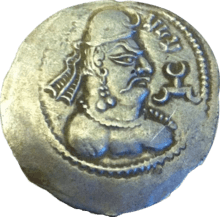 Silver drachm of Mehama legend: “ṣāhi mehama", mid-late 5th century.
Silver drachm of Mehama legend: “ṣāhi mehama", mid-late 5th century. Silver drachm of Lakhana, late 5th-early 6th centuries.
Silver drachm of Lakhana, late 5th-early 6th centuries. Gold dinar of Adomano, Kushano-Sasanian style, mid-late 5th century.
Gold dinar of Adomano, Kushano-Sasanian style, mid-late 5th century.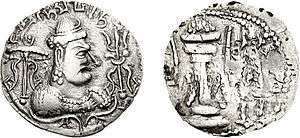 Silver drachm of Mihirakula, early-mid 6th century.
Silver drachm of Mihirakula, early-mid 6th century.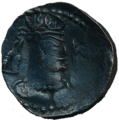 Bronze drachm of Toramana II wearing trident crown, late-phase Gandharan style. mid 6th century.
Bronze drachm of Toramana II wearing trident crown, late-phase Gandharan style. mid 6th century. Silver stater of Toramana II, Kashmir style, mid-late 6th century.
Silver stater of Toramana II, Kashmir style, mid-late 6th century. Bronze drachm of Narana-Narenda (possibly Toramana II) wearing trident crown, late 6th century.
Bronze drachm of Narana-Narenda (possibly Toramana II) wearing trident crown, late 6th century.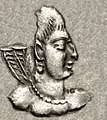 Khingila as a young king, without headdress. Artificial cranial deformation clearly visible.
Khingila as a young king, without headdress. Artificial cranial deformation clearly visible.- Vishnu Nicolo Seal representing Vishnu with a worshipper (probably Mihirakula), 4th–6th century CE. The inscription in cursive Bactrian reads: "Mihira, Vishnu and Shiva". British Museum.
Notes
- "Here, for the first time, the names of Hepthalite (Alchon) kings are given, some of them otherwise known only from coins. Another important fact is that it dates all these kings in the same time." from Aydogdy Kurbanov (2010). The hephthalites: archaeological and historical analysis. Berlin: Free University of Berlin. p. 120. OCLC 863884689. Retrieved 17 June 2018.
- "After the successful conclusion of the Eran episode, the conquering Hunas ultimately burst out of Eastern Malwa and swooped down upon the very heart of the Gupta empire. The eastern countries were overrun and the city of the Gaudas was occupied. The Manjusrimulakalpa gives a scintillating account of this phase of Toramana’s conquest. It says that after Bhanugupta's defeat and discomfiture, Toramana led the Hunas against Magadha and obliged Baladitya (Narasimha-gupta Baladitya, the reigning Gupta monarch) to retire to Bengal. This great monarch (Toramana), Sudra by caste and possessed of great prowess and armies took hold of that position (bank of the Ganges) and commanded the country round about. That powerful king then invested the town called Tirtha in the Gauda country." in Upendra Thakur (1967). The Hūṇas in India. 58. Varanasi: Chowkhamba Sanskrit Series Office. p. 122. OCLC 551489665.
- "The earth betook itself (for succour), when it was afflicted by kings of the present age, who manifested pride; who were cruel through want of proper training; who,from delusion, transgressed the path of good conduct; (and) who were destitute of virtuous delights " from "Sondhni pillars: where Punjabis met with their Waterloo 1500 years ago". Punjab Monitor. Amritsar: Bhai Nand Lal Foundation. 27 April 2013. Retrieved 8 July 2018.
- "Together with the great sahi Khingila, together with the god-king Toramana, together with the mistress of a great monastery Sasa, together with the great sahi Mehama, together with Sadavikha, together with the great king Javukha, the son of Sadavikha, during the reign of Mehama."from Gudrun Melzer; Lore Sander (2000). Jens Braarvig (ed.). A Copper Scroll Inscription from the Time of the Alchon Huns. Buddhist manuscripts. 3. Oslo: Hermes Pub. pp. 251–278. ISBN 9788280340061.
- For an image of the copper scroll: Coin Cabinet of the Kunsthistorisches Museum Vienna Showcase 8
- For equivalent coin, see CNG Coins
- This coin is in the collection of the British Museum. For equivalent coin, see CNG Coins
References
- Rezakhani, Khodadad (2017). ReOrienting the Sasanians: East Iran in Late Antiquity. Edinburgh University Press. pp. 105–124. ISBN 9781474400305.
- Hans T. Bakker (26 November 2016). Monuments of Hope, Gloom, and Glory in the Age of the Hunnic Wars: 50 years that changed India (484 - 534) (Speech). 24th Gonda Lecture. Amsterdam. Archived from the original on 25 November 2016. Retrieved 8 July 2018.
- "The Alchon Huns....established themselves as overlords of northwestern India, and directly contributed to the downfall of the Guptas" in Neelis, Jason (2010). Early Buddhist Transmission and Trade Networks: Mobility and Exchange Within and Beyond the Northwestern Borderlands of South Asia. BRILL. p. 162. ISBN 9789004181595.
- Bakker, Hans (2017), Monuments of Hope, Gloom and Glory in the Age of the Hunnic Wars: 50 years that changed India (484–534), Royal Netherlands Academy of Arts and Sciences, Section 4, ISBN 978-90-6984-715-3
- "Note 8: It is now clear that the Hephtalites were not part of those Huns who conquered the land south of the Hindu-Kush and Sind as well in the early 6th century. In fact, this latter Hunnic group was the one commonly known as Alkhon because of the inscriptions on their coins (Vondrovec, 2008)." in Compareti, Matteo (2014). Some Examples of Central Asian Decorative Elements in Ajanta and Bagh Indian Paintings (PDF). The Silk Road Foundation.
- Rezakhani, Khodadad. From the Kushans to the Western Turks. p. 207.
- Michael Maas (29 September 2014). The Cambridge Companion to the Age of Attila. New York: Cambridge University Press. p. 286. ISBN 978-1-316-06085-8.
- Gupta, Parmanand (1989). Geography from Ancient Indian Coins & Seals. Concept Publishing Company. pp. 174–175. ISBN 9788170222484.
- Tewari, S.P.; Ramesh, K.V. (1983). JOURNAL OF THE EPIGRAPHICAL SOCIETY OF INDIA VOL 10. THE EPIGRAPHICAL SOCIETY OF INDIA, DHARWAR. pp. 98–99.
- Salomon, Richard (1989). "New Inscriptional Evidence For The History Of The Aulikaras of Mandasor". Indo-Iranian Journal. 32 (1): 4 and 27. doi:10.1163/000000089790082971. ISSN 0019-7246. JSTOR 24654606.
-

- Alemany, Agustí (2000). Sources on the Alans: A Critical Compilation. BRILL. p. 346. ISBN 9004114424.
- CNG Coins
- Ahmad Hasan Dani; B. A. Litvinsky; Unesco (1 January 1996). History of Civilizations of Central Asia: The crossroads of civilizations, A.D. 250 to 750. Paris: UNESCO. p. 119. ISBN 978-92-3-103211-0.
- Hyun Jin Kim (19 November 2015). The Huns. Abingdon-on-Thames: Routledge. p. 50. ISBN 978-1-317-34090-4.
- Alemany, Agustí (2000). Sources on the Alans: A Critical Compilation. BRILL. p. 345. ISBN 9004114424.
- Braarvig, Jens (2000). Buddhist Manuscripts (Vol.3 ed.). Hermes Pub. p. 257. ISBN 9788280340061.
- For one of these coins
- Rezakhani, Khodadad (2017). ReOrienting the Sasanians: East Iran in Late Antiquity. Edinburgh University Press. p. 199. ISBN 9781474400312.
- Kim, Hyun Jin (2015). The Huns. Routledge. p. 53. ISBN 9781317340904.
- Tandon, Pankaj (2013). "Notes on the Evolution of Alchon Coins" (PDF). Journal of the Oriental Numismatic Society (216): 24–34. Retrieved 8 July 2018.
- CNG Coins
- Neelis, Jason (2010). Early Buddhist Transmission and Trade Networks: Mobility and Exchange Within and Beyond the Northwestern Borderlands of South Asia. BRILL. p. 159. ISBN 978-9004181595.
- Scheers, Simone; Quaegebeur, Jan (1982). Studia Paulo Naster Oblata: Orientalia antiqua (in French). Peeters Publishers. p. 55. ISBN 9789070192105.
- Ammianus Marcellinus, Roman History. London: Bohn (1862) XVI-IX
- Ammianus Marcellinus, Roman History. London: Bohn (1862) XVII-V
- Cosmo, Nicola Di; Maas, Michael (2018). Empires and Exchanges in Eurasian Late Antiquity: Rome, China, Iran, and the Steppe, ca. 250–750. Cambridge University Press. p. 698. ISBN 9781108547000.
- History of Civilizations of Central Asia, Ahmad Hasan Dani, B. A. Litvinsky, Unesco p.38 sq
- CNG Coins
- Rienjang, Wannaporn; Stewart, Peter (2018). Problems of Chronology in Gandhāran Art: Proceedings of the First International Workshop of the Gandhāra Connections Project, University of Oxford, 23rd-24th March, 2017. Archaeopress. p. 23. ISBN 9781784918552.
- ALRAM, MICHAEL (2014). "From the Sasanians to the Huns New Numismatic Evidence from the Hindu Kush". The Numismatic Chronicle (1966-). 174: 268. ISSN 0078-2696. JSTOR 44710198.
- Jason Neelis (19 November 2010). Early Buddhist Transmission and Trade Networks: Mobility and Exchange Within and Beyond the Northwestern Borderlands of South Asia. Leiden: BRILL. ISBN 978-90-04-18159-5.
- Rezakhani, Khodadad (2017). ReOrienting the Sasanians: East Iran in Late Antiquity. Edinburgh University Press. p. 118. ISBN 9781474400305.
- Rezakhani, Khodadad (2017). ReOrienting the Sasanians: East Iran in Late Antiquity. Edinburgh University Press. pp. 120–122. ISBN 9781474400305.
- Dani, Ahmad Hasan; Litvinsky, B. A. (1996). History of Civilizations of Central Asia: The crossroads of civilizations, A.D. 250 to 750. UNESCO. pp. 123–126. ISBN 9789231032110.
- Ghosh, Amalananda (1965). Taxila. CUP Archive. p. 791.
- Le, Huu Phuoc (2010). Buddhist Architecture. Grafikol. ISBN 9780984404308. Retrieved 24 March 2017.
- Kurbanov, Aydogdy (2010). The hephthalites: archaeological and historical analysis (PDF) (Phd thesis). Berlin: Free University of Berlin. p. 120. OCLC 863884689. Retrieved 17 June 2018.
- Brancaccio, Pia (2010). The Buddhist Caves at Aurangabad: Transformations in Art and Religion. BRILL. pp. 105–106. ISBN 9789004185258.
- Senior, R.C. (1991). "The Coinage of Sind from 250 AD up to the Arab Conquest" (PDF). Oriental Numismatic Society. 129 (June–July 1991): 3–4.
- Schindel, Nikolaus; Alram, Michael; Daryaee, Touraj; Pendleton, Elizabeth (2016). The Parthian and Early Sasanian Empires: adaptation and expansion. Oxbow Books. pp. 126–129. ISBN 9781785702105.
- Brancaccio, Pia (2010). The Buddhist Caves at Aurangabad: Transformations in Art and Religion. BRILL. p. 106. ISBN 9789004185258.
- Auctores Varii (2016). Ajanta Dipinta - Painted Ajanta Vol. 1 e 2: Studio sulla tecnica e sulla conservazione del sito rupestre indiano - Studies on the techniques and the conservation of the indian rock art site. Gangemi Editore. pp. 58–59. ISBN 9788849274905.
- Brancaccio, Pia (2010). The Buddhist Caves at Aurangabad: Transformations in Art and Religion. BRILL. pp. 106–107. ISBN 9789004185258.
- Indian Archaeology 1954-55 A review (PDF). p. 18.
- Hans Bakker (16 July 2014). The World of the Skandapurāṇa. Leiden: BRILL. p. 34. ISBN 978-90-04-27714-4.
- V.K. Agnihotri, ed. (2010). Indian History (26 ed.). New Delhi: Allied Publishers. p. 81. ISBN 978-81-8424-568-4.
- Bindeshwari Prasad Sinha (1977). Dynastic History of Magadha, Cir. 450-1200 A.D. New Delhi: Abhinav Publications. GGKEY:KR1EJ2EGCTJ.
- Parmanand Gupta (1989). Geography from Ancient Indian Coins & Seals. New DELHI: Concept Publishing Company. p. 175. ISBN 978-81-7022-248-4.
- Radhakumud Mookerji (1997). The Gupta Empire (5th ed.). Delhi: Motilal Banarsidass. p. 120. ISBN 978-81-208-0440-1.
- Upendra Thakur (1967). The Hūṇas in India. 58. Varanasi: Chowkhamba Sanskrit Series Office. p. 122. OCLC 551489665.
- Raj Kumar (2010). Early history of Jammu region. 2. Delhi: Gyan Publishing House. p. 538. ISBN 978-81-7835-770-6.
- Coin Cabinet of the Kunsthistorisches Museum Vienna
- Fleet, John Faithfull (1960). Inscriptions Of The Early Gupta Kings And Their Successors. pp. 158–161.
- CNG Coins
- The Identity of Prakasaditya by Pankaj Tandon, Boston University
- "This makes it quite clear that the Alchon Huns in India must have had a substantial and rich empire, with the capacity to issue a relatively large volume of gold coins." in TANDON, PANKAJ (7 July 2015). "The Identity of Prakāśāditya". Journal of the Royal Asiatic Society. 25 (4): 668. doi:10.1017/S1356186315000346. hdl:2144/37851. S2CID 43869990. Full article
- Om Prakash Misra (2003). Archaeological Excavations in Central India: Madhya Pradesh and Chhattisgarh. New Delhi: Mittal Publications. p. 7. ISBN 978-81-7099-874-7.
- S. B. Bhattacherje (1 May 2009). Encyclopaedia of Indian Events & Dates. A15. New Delhi: Sterling Publishers Pvt. Ltd. ISBN 978-81-207-4074-7.
- R.K. Pruthi (2004). The Classical Age. New Delhi: Discovery Publishing House. p. 262. ISBN 978-81-7141-876-3.
- N. K. Ojha (2001). The Aulikaras of Central India: history and inscriptions. Chandigarh: Arun Pub. House. pp. 48–50. ISBN 978-81-85212-78-4.
- Tej Ram Sharma (1978). Personal and Geographical Names in the Gupta Inscriptions. Delhi: Concept Publishing Company. p. 232. OCLC 923058151. GGKEY:RYD56P78DL9.
- Hsüan-tsang, ca 596-664; Beal, Samuel (1884). Si-yu-ki, Buddhist records of the Western world;. London : Trübner. p. 167.
- "Sondhni pillars: where Punjabis met with their Waterloo 1500 years ago". Punjab Monitor. Amritsar: Bhai Nand Lal Foundation. 27 April 2013. Retrieved 8 July 2018.
- The "h" (

- The "h" (

- Verma, Thakur Prasad (2018). The Imperial Maukharis: History of Imperial Maukharis of Kanauj and Harshavardhana (in Hindi). Notion Press. p. 264. ISBN 9781643248813.
- Sircar, D. C. (2008). Studies in Indian Coins. Motilal Banarsidass. p. 376. ISBN 9788120829732.
- Tandon, Pankaj (2013). Notes on the Evolution of Alchon Coins Journal of the Oriental Numismatic Society, No. 216, Summer. Oriental Numismatic Society. pp. 24–34. also Coinindia Alchon Coins (for an exact description of this coin type)
- John Faithfull Fleet (1888). John Faithfull Fleet (ed.). Corpus Inscriptionum Indicarum: Inscriptions of the early Gupta kings and their successors. 3. Calcutta: Office of the Superintendent of Government Print. pp. 147–148. OCLC 69001098. Archived from the original on 1 July 2015.
- Kailash Chand Jain (31 December 1972). Malwa Through The Ages. Dewlhi: Motilal Banarsidass. p. 249. ISBN 978-81-208-0824-9.
- Abraham Eraly (2011). The First Spring: The Golden Age of India. New Delhi: Penguin Books India. p. 48. ISBN 978-0-670-08478-4.
- Ashvini Agrawal (1989). Rise and Fall of the Imperial Guptas. Delhi: Motilal Banarsidass. p. 245. ISBN 978-81-208-0592-7.
- Dani, Ahmad Hasan; Litvinsky, B. A. (1996). History of Civilizations of Central Asia: The crossroads of civilizations, A.D. 250 to 750. UNESCO. p. 169. ISBN 9789231032110.
- Kim, Hyun Jin (2015). The Huns. Routledge. p. 58. ISBN 9781317340911.
- M. A. Stein (1989). Kalhana's Rajatarangini: a chronicle of the kings of Kasmir. Motilal Banarsidass. pp. 439–441. ISBN 978-81-208-0370-1.
- Dani, Ahmad Hasan; Litvinsky, B. A. (1996). History of Civilizations of Central Asia: The crossroads of civilizations, A.D. 250 to 750. UNESCO. p. 170. ISBN 9789231032110.
- CNG Coins
- Sailendra Nath Sen (1999). Ancient Indian History and Civilization. New Delhi: New Age International. ISBN 978-81-224-1198-0.
- Klaus Vondrovec (2014). Coinage of the Iranian Huns and Their Successors from Bactria to Gandhara (4th to 8th Century CE). Vienna: Austrian Academy of Sciences Press. ISBN 978-3-7001-7695-4.
- de la Vaissiere, Etienne (2007). "A Note on the Schøyen Copper Scroll: Bactrian or Indian?" (PDF). Bulletin of the Asia Institute. 21: 127. JSTOR i24047314. Retrieved 8 July 2018.
- René Grousset (1970). The Empire of the Steppes: A History of Central Asia. New Brunswick: Rutgers University Press. p. 71. ISBN 978-0-8135-1304-1.
- Behrendt, Kurt A. (2004). Handbuch der Orientalistik. Leiden: BRILL. ISBN 9789004135956.
- Ann Heirman; Stephan Peter Bumbacher (11 May 2007). The Spread of Buddhism. Leiden: BRILL. p. 60. ISBN 978-90-474-2006-4.
- Upinder Singh (2008). A History of Ancient and Early Medieval India: From the Stone Age to the 12th Century. Delhi: Pearson Education India. p. 521. ISBN 978-81-317-1120-0.
- Sankalia, Hasmukhlal Dhirajlal (1934). The University of Nālandā. Madras: B. G. Paul & co. OCLC 988183829.
- Sukumar Dutt (1988) [First published in 1962]. Buddhist Monks And Monasteries of India: Their History And Contribution To Indian Culture. London: George Allen and Unwin Ltd. ISBN 81-208-0498-8.
- J. Gordon Melton (15 January 2014). Faiths Across Time: 5,000 Years of Religious History: 5,000 Years of Religious History. 1. Santa Barbara: ABC-CLIO. p. 455. ISBN 978-1-61069-026-3.
- Krishna Chandra Sagar (1992). Foreign Influence on Ancient India. New Delhi: Northern Book Centre. p. 270. ISBN 978-81-7211-028-4.
- Lal Mani Joshi (1987). Studies in the Buddhistic Culture of India During the Seventh and Eighth Centuries A.D. Delhi: Motilal Banarsidass. p. 320. ISBN 978-81-208-0281-0.
- "He is credited with the building of the temple named Jyeshteswara on the Gopa (Sankaracharya) hill in Srinagar" in Bamzai, Prithivi Nath Kaul (1980). Kashmir and Central Asia. Light & Life Publishers. p. 63.
- Rezakhani, Khodadad (2017). ReOrienting the Sasanians: East Iran in Late Antiquity. Edinburgh University Press. p. 112. ISBN 9781474400305.
- A Comprehensive History Of Ancient India (3 Vol. Set). New Delhi: Sterling Publishers Pvt. Ltd. 1 December 2003. p. 174. ISBN 978-81-207-2503-4.
- Singh (2010). Longman History & Civics ICSE 9. New Delhi: Pearson Education India. p. 81. ISBN 978-81-317-2041-7.
- Parmentier, Henri (1930). "J. Ph. Vogel : La sculpture de Mathurâ". Bulletin de l'École française d'Extrême-Orient. 30 (1): 457.
- Brancaccio, Pia (2010). The Buddhist Caves at Aurangabad: Transformations in Art and Religion. Leiden: BRILL. p. 107. ISBN 978-9004185258.
- Ray, Himanshu Prabha (2019). Negotiating Cultural Identity: Landscapes in Early Medieval South Asian History. Taylor & Francis. pp. 161–165. ISBN 9781000227932.
- Robert Göbl (1967). Dokumente zur Geschichte der iranischen Hunnen in Baktrien und Indien. Wiesbaden: Otto Harrassowitz Verlag. OCLC 2561645. GGKEY:4TALPN86ZJB.
- Gudrun Melzer; Lore Sander (2000). Jens Braarvig (ed.). A Copper Scroll Inscription from the Time of the Alchon Huns. Buddhist manuscripts. 3. Oslo: Hermes Pub. pp. 251–278. ISBN 9788280340061.
- Tandon, Pankaj (2013). Notes on the Evolution of Alchon Coins Journal of the Oriental Numismatic Society, No. 216, Summer. Oriental Numismatic Society. pp. 24–34. also Coinindia Alchon Coins (for an exact description of this coin type)
- Rienjang, Wannaporn; Stewart, Peter (2018). Problems of Chronology in Gandhāran Art: Proceedings of the First International Workshop of the Gandhāra Connections Project, University of Oxford, 23rd-24th March, 2017. Archaeopress. p. 23. ISBN 9781784918552.
- Tandon, Pankaj (2015). "The Identity of Prakasaditya" (PDF). Journal of the Royal Asiatic Society. 25 (4): 647–668. doi:10.1017/S1356186315000346. hdl:2144/37851. Retrieved 8 July 2018.
- Smith, Vincent Arthur; Edwardes, S. M. (Stephen Meredyth) (1924). The early history of India : from 600 B.C. to the Muhammadan conquest, including the invasion of Alexander the Great. Oxford : Clarendon Press. p. Plate 2.
- CNG Coins
External links
| Wikimedia Commons has media related to Alchon Huns. |
- Nezak Kings in Zabulistan and Kabulistan Coin Cabinet of the Kunsthistorisches Museum Vienna
- Coinage of the Hephthalites/ Alchons, Grifterrec
| Timeline and cultural period |
Northwestern India (Punjab-Sapta Sindhu) |
Indo-Gangetic Plain | Central India | Southern India | ||
| Upper Gangetic Plain (Ganga-Yamuna doab) |
Middle Gangetic Plain | Lower Gangetic Plain | ||||
| IRON AGE | ||||||
| Culture | Late Vedic Period | Late Vedic Period (Srauta culture)[lower-alpha 1] Painted Grey Ware culture |
Late Vedic Period (Shramanic culture)[lower-alpha 2] Northern Black Polished Ware |
Pre-history | ||
| 6th century BC | Gandhara | Kuru-Panchala | Magadha | Adivasi (tribes) | ||
| Culture | Persian-Greek influences | "Second Urbanisation" Rise of Shramana movements Jainism - Buddhism - Ājīvika - Yoga |
Pre-history | |||
| 5th century BC | (Persian conquests) | Shaishunaga dynasty | Adivasi (tribes) | |||
| 4th century BC | (Greek conquests) | Nanda empire | ||||
| HISTORICAL AGE | ||||||
| Culture | Spread of Buddhism | Pre-history | Sangam period (300 BC – 200 AD) | |||
| 3rd century BC | Maurya Empire | Early Cholas Early Pandyan Kingdom Satavahana dynasty Cheras 46 other small kingdoms in Ancient Thamizhagam | ||||
| Culture | Preclassical Hinduism[lower-alpha 3] - "Hindu Synthesis"[lower-alpha 4] (ca. 200 BC - 300 AD)[lower-alpha 5][lower-alpha 6] Epics - Puranas - Ramayana - Mahabharata - Bhagavad Gita - Brahma Sutras - Smarta Tradition Mahayana Buddhism |
Sangam period (continued) (300 BC – 200 AD) | ||||
| 2nd century BC | Indo-Greek Kingdom | Shunga Empire Maha-Meghavahana Dynasty |
Early Cholas Early Pandyan Kingdom Satavahana dynasty Cheras 46 other small kingdoms in Ancient Thamizhagam | |||
| 1st century BC | ||||||
| 1st century AD | Kuninda Kingdom | |||||
| 2nd century | Kushan Empire | |||||
| 3rd century | Kushano-Sasanian Kingdom | Kushan Empire | Western Satraps | Kamarupa kingdom | Kalabhra dynasty Pandyan Kingdom (Under Kalabhras) | |
| Culture | "Golden Age of Hinduism"(ca. AD 320-650)[lower-alpha 7] Puranas Co-existence of Hinduism and Buddhism | |||||
| 4th century | Kidarites | Gupta Empire Varman dynasty |
Kalabhra dynasty Pandyan Kingdom (Under Kalabhras) Kadamba Dynasty Western Ganga Dynasty | |||
| 5th century | Hephthalite Empire | Alchon Huns | Kalabhra dynasty Pandyan Kingdom (Under Kalabhras) Vishnukundina | |||
| 6th century | Nezak Huns Kabul Shahi |
Maitraka | Adivasi (tribes) | Badami Chalukyas Kalabhra dynasty Pandyan Kingdom (Under Kalabhras) | ||
| Culture | Late-Classical Hinduism (ca. AD 650-1100)[lower-alpha 8] Advaita Vedanta - Tantra Decline of Buddhism in India | |||||
| 7th century | Indo-Sassanids | Vakataka dynasty Empire of Harsha |
Mlechchha dynasty | Adivasi (tribes) | Pandyan Kingdom (Under Kalabhras) Pandyan Kingdom(Revival) Pallava | |
| 8th century | Kabul Shahi | Pala Empire | Pandyan Kingdom Kalachuri | |||
| 9th century | Gurjara-Pratihara | Rashtrakuta dynasty Pandyan Kingdom Medieval Cholas Pandyan Kingdom (Under Cholas) Chera Perumals of Makkotai | ||||
| 10th century | Ghaznavids | Pala dynasty Kamboja-Pala dynasty |
Kalyani Chalukyas Medieval Cholas Pandyan Kingdom (Under Cholas) Chera Perumals of Makkotai Rashtrakuta | |||
References and sources for table References
Sources
| ||||||

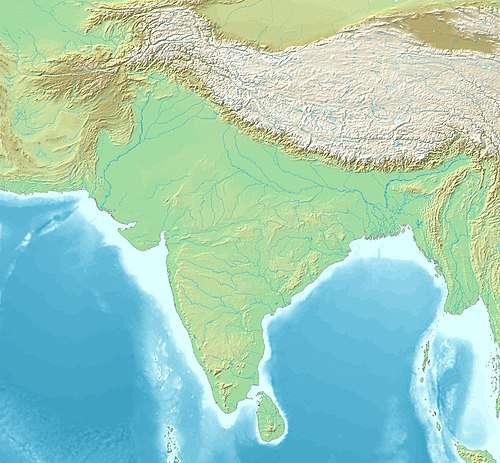




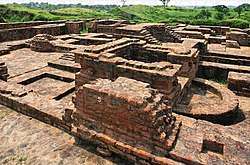
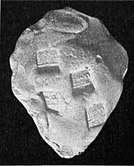
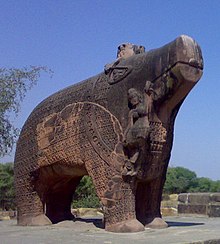


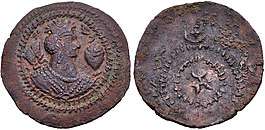
.jpg)
